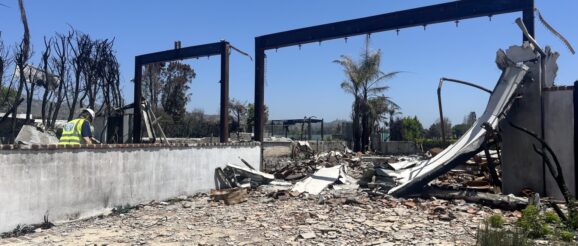LA fire clean-up and recovery is fast but is it safe?

LOS ANGELES — Diana Lieb was already on the fence about rebuilding after the Eaton Fire swept through her Altadena, Calif., neighborhood and burned down her house on January 7.
But when she heard there could still be toxins in the soils even after federal clean-up crews removed all the debris from her lot, it was the last straw.
“It would mean rebuilding a home where my kids are gonna grow up, obviously I don’t want them to be on land that is toxic,” Lieb says. “There has not been much communication about what is healthy to be around.”
Lieb and her husband bought in Altadena nine years ago because it was one of the last affordable places in greater-Los Angeles. Their home was originally built in 1926.
In April in a widely circulated report, Los Angeles County health officials found more than a quarter of properties in the Eaton Fire scraped by federal crews still had toxins above California standards.
Lieb decided to list her lot on the market a few days ago. For now, she and her family will continue to live with her parents in West LA.
She says they’ll stay there until they can find a condo near her daughters’ new school.
“It’s just been so much upheaval. I want peace,” she says.
The removal of fire debris is months ahead of schedule
LA is approaching the five-month mark since January’s wildfires killed 30 people and destroyed more than 16,000 structures, many of them homes. Combined, the Eaton and Palisades fires were among the most destructive fires in California history with an estimated $95 to $164 billion in total capital and property losses, according to UCLA’s Anderson School of Management.
Initially, federal disaster officials said it could take up to 18 months to clear all the debris. An executive order signed by President Trump in late January ordered a fast-tracking of debris removal. And today the clean-up is months ahead of schedule, with predictions that the entire project could be done as early as this July, according to FEMA. There’s political and public pressure to make it easier for fire survivors to rebuild. But a growing number of disaster recovery experts and scientists are questioning whether it’s safe.
“How do we know that soil is safe?” says Andrew Whelton, an engineering professor at Purdue University. “Once a disaster like this happens, a number of things we never thought imaginable show up in our lives.”

Whelton is nationally known for exposing unexpected hazards that crop up after disasters. His work specifically focused on the removal of toxic chemicals from drinking water.
In 2018, his team discovered the water supply in the California town of Paradise was compromised in the aftermath of the deadly Camp Fire. Lately, he’s been in LA pushing for comprehensive testing of soils after the lots in the wildfire zone are cleared, something FEMA is no longer required to do nationally.
“It’s unclear to me why this is different but it clearly is and this is a problem towards a safe and rapid rebuilding,” he says.
On a street in Altadena, residential lots that were recently cleaned up and graded display U.S. Army Corps signs, which indicate it’s ok to start building . But Whelton says after destructive fires, there are often lingering toxins from exploded propane tanks or burned cars and high levels of lead from home exteriors after the debris is removed.
“They used to be bound up in paint and now they’re released into the soil and the question is should we let our kids play in that soil,” Whelton asks. “How do we know that soil is safe? The only way to do that is by testing.”
FEMA is not testing for lingering toxins
The agency has told other news outlets that the 6-inch rule has replaced more in-depth soil testing unless there’s an immediate hazard.
Whelton disagrees. He says it’s standard protocol to test soils as part of the debris removal process. He notes that sampling was carried out in the aftermath of the Camp Fire, the 2021 Marshall Fire in suburban Colorado and the 2023 blazes on Maui. Members of California’s congressional delegation joined Gov. Gavin Newsom in appealing FEMA’s decision but so far the agency hasn’t budged on its decision not to conduct further testing.
“Speed cannot mean that rebuilding would be done in a sloppy manner or that we would skip steps,” Bass said.

Thousands of survivors are still in limbo five months later
But no matter how many steps leaders say they’ll take, it’s too late for many survivors who are giving up and making plans to leave the neighborhoods they once called home.
“Every time that they’re cleaning up there, they’re kicking all of that stuff back up into the air as well,” says Kwynn Perry, whose rental home burned in Altadena.
Perry and her husband, an elementary school principal, recently got their teenage son into a new school in another part of the city and found a new condo to rent at close to double the price they were paying in Altadena.
They didn’t have insurance at the time of the Eaton Fire and now have to pay out of pocket to replace nearly all their belongings.
“Even though we’re in a better place, we still feel like we’re treading water every day,” Perry says.
